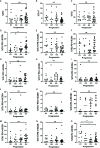T-Helper Cell Subset Response Is a Determining Factor in COVID-19 Progression
- PMID: 33718270
- PMCID: PMC7952877
- DOI: 10.3389/fcimb.2021.624483
T-Helper Cell Subset Response Is a Determining Factor in COVID-19 Progression
Abstract
The immune response type organized against viral infection is determinant in the prognosis of some infections. This work has aimed to study Th polarization in acute COVID-19 and its possible association with the outcome through an observational prospective study. Fifty-eight COVID-19 patients were recruited in the Medicine Department of the hospital "12 de Octubre," 55 patients remaining after losses to follow-up. Four groups were established according to maximum degree of disease progression. T-helper cell percentages and phenotypes, analyzed by flow cytometer, and serum cytokines levels, analyzed by Luminex, were evaluated when the microbiological diagnosis (acute phase) of the disease was obtained. Our study found a significant reduction of %Th1 and %Th17 cells with higher activated %Th2 cells in the COVID-19 patients compared with reference population. A higher percent of senescent Th2 cells was found in the patients who died than in those who survived. Senescent Th2 cell percentage was an independent risk factor for death (OR: 13.88) accompanied by the numbers of total lymphocytes (OR: 0.15) with an AUC of 0.879. COVID-19 patients showed a profile of pro-inflammatory serum cytokines compared to controls, with higher levels of IL-2, IL-6, IL-15, and IP-10. IL-10 and IL-13 were also elevated in patients compared to controls. Patients who did not survive presented significantly higher levels of IL-15 than those who recovered. No significant differences were observed according to disease progression groups. The study has shown that increased levels of IL-15 and a high Th2 response are associated with a fatal outcome of the disease.
Keywords: COVID-19; SARS-Cov2; T-helper; cytokines; immunity.
Copyright © 2021 Gil-Etayo, Suàrez-Fernández, Cabrera-Marante, Arroyo, Garcinuño, Naranjo, Pleguezuelo, Allende, Mancebo, Lalueza, Díaz-Simón, Paz-Artal and Serrano.
Conflict of interest statement
The authors declare that the research was conducted in the absence of any commercial or financial relationships that could be construed as a potential conflict of interest.
Figures


Similar articles
-
Different polarization and functionality of CD4+ T helper subsets in people with post-COVID condition.Front Immunol. 2024 Aug 27;15:1431411. doi: 10.3389/fimmu.2024.1431411. eCollection 2024. Front Immunol. 2024. PMID: 39257580 Free PMC article.
-
Negative Clinical Evolution in COVID-19 Patients Is Frequently Accompanied With an Increased Proportion of Undifferentiated Th Cells and a Strong Underrepresentation of the Th1 Subset.Front Immunol. 2020 Nov 26;11:596553. doi: 10.3389/fimmu.2020.596553. eCollection 2020. Front Immunol. 2020. PMID: 33324414 Free PMC article.
-
Characterizing the immune responses of those who survived or succumbed to COVID-19: Can immunological signatures predict outcome?Cytokine. 2021 Apr;140:155439. doi: 10.1016/j.cyto.2021.155439. Epub 2021 Jan 15. Cytokine. 2021. PMID: 33524886 Free PMC article.
-
Revisiting the Th1/Th2 paradigm.Scand J Immunol. 1998 Jan;47(1):1-9. doi: 10.1111/j.1365-3083.1998-47-1.00383.x. Scand J Immunol. 1998. PMID: 9467651 Review.
-
T helper cells plasticity in inflammation.Cytometry A. 2014 Jan;85(1):36-42. doi: 10.1002/cyto.a.22348. Epub 2013 Sep 5. Cytometry A. 2014. PMID: 24009159 Review.
Cited by
-
Cytidine deamination-induced perpetual immunity to SAR-CoV-2 infection is a potential new therapeutic target.Int J Med Sci. 2021 Oct 15;18(16):3788-3793. doi: 10.7150/ijms.61779. eCollection 2021. Int J Med Sci. 2021. PMID: 34790054 Free PMC article. Review.
-
PI3Kγ inhibition circumvents inflammation and vascular leak in SARS-CoV-2 and other infections.Sci Transl Med. 2024 Jul 3;16(754):eadi6887. doi: 10.1126/scitranslmed.adi6887. Epub 2024 Jul 3. Sci Transl Med. 2024. PMID: 38959328 Free PMC article.
-
Elevated ubiquitination contributes to protective immunity against severe SARS-CoV-2 infection.Clin Transl Med. 2022 Dec;12(12):e1103. doi: 10.1002/ctm2.1103. Clin Transl Med. 2022. PMID: 36447039 Free PMC article.
-
Non-fatal outcomes of COVID-19 disease in pediatric organ transplantation associates with down-regulation of senescence pathways.Sci Rep. 2024 Jan 22;14(1):1877. doi: 10.1038/s41598-024-52456-y. Sci Rep. 2024. PMID: 38253675 Free PMC article.
-
Immune responses in mildly versus critically ill COVID-19 patients.Front Immunol. 2023 Jan 30;14:1077236. doi: 10.3389/fimmu.2023.1077236. eCollection 2023. Front Immunol. 2023. PMID: 36793739 Free PMC article. Review.
References
-
- Alberts B., Johnson A., Lewis J., Raff M., Roberts K., Walter P. (2002). Molecular Biology of the Cell. Helper T Cells and Lymphocyte Activation. 4th edition, New York: Garland Science. Available at: https://www.ncbi.nlm.nih.gov/books/NBK26827/.
-
- Annunziato F., Galli G., Cosmi L., Romagnani P., Manetti R., Maggi E., et al. . (1998). Molecules Associated with Human Th1 or Th2 Cells. Eur. Cytokine Netw. 9 (3 Suppl), 12–16. - PubMed
Publication types
MeSH terms
Substances
LinkOut - more resources
Full Text Sources
Other Literature Sources
Medical
Miscellaneous

